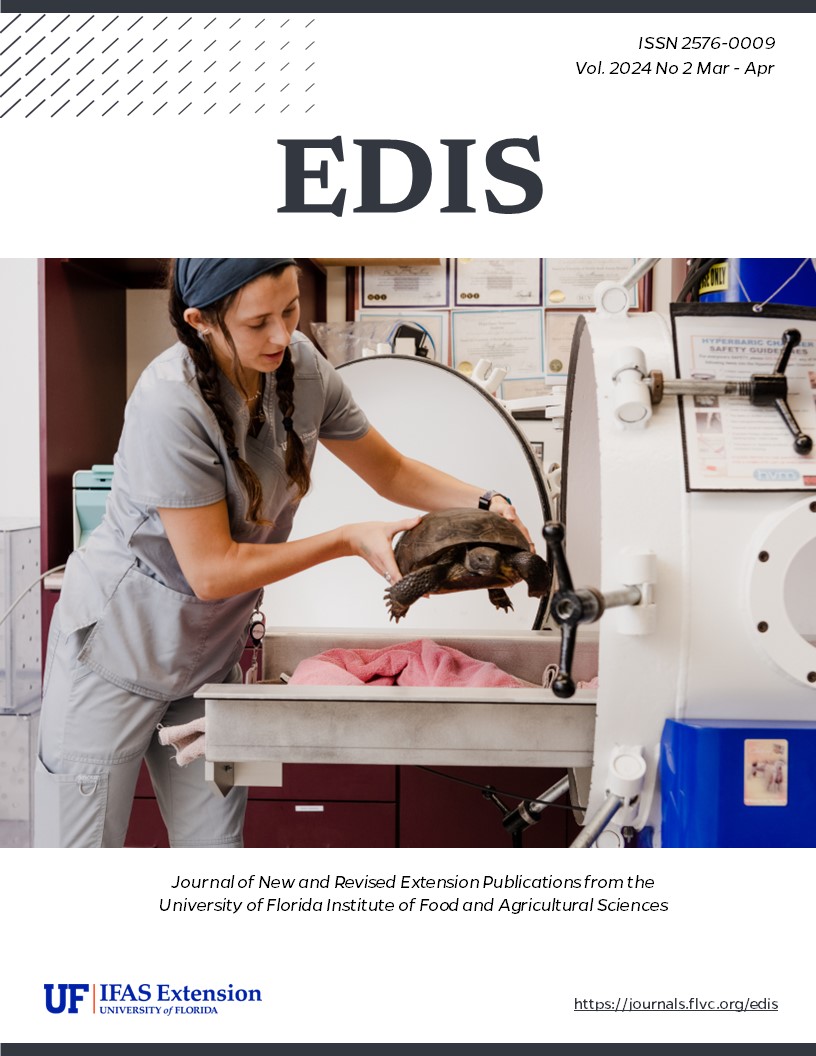Abstract
The genus Rickettsia contains species that are important in human health as they cause several serious diseases such as Rocky Mountain spotted fever. This publication summarizes the human-disease-causing pathogens in the genus Rickettsia in the United States and delivers general knowledge of their vectors and the diseases they cause. Prevention and management of disease-causing Rickettsia species, mainly for vector control agencies and entities, are also discussed. This publication is written for audiences of all ages and with any educational background and serves as a resource for public education.
References
Adjemian, J., S. Parks, K. McElroy, J. Campbell, M. E. Eremeeva, W. L. Nicholson, J. McQuiston, and J. Taylor. 2010. “Murine Typhus in Austin, Texas, USA, 2008.” Emerging Infectious Diseases 16:412–417. https://doi.org/10.3201/eid1603.091028
Azad, A. F., and C. B. Beard. 1998. “Rickettsial Pathogens and Their Arthropod Vectors.” Emerging Infectious Diseases 4:179–186. https://www.ncbi.nlm.nih.gov/pmc/articles/PMC2640117/
Bechah, Y., C. Capo, J. L. Mege, and D. Raoult. 2008. “Epidemic Typhus.” The Lancet Infectious Diseases 8:417–426. https://doi.org/10.1016/S1473-3099(08)70150-6
Blanton, L. S., B. R. Quade, A. Ramírez-Hernández, N. L. Mendell, A. Villasante-Tezanos, D. H. Bouyer, J. L. VandeBerg, and D. H. Walker. 2022. “Experimental Rickettsia typhi Infection in Monodelphis domestica: Implications for Opossums as an Amplifying Host in the Suburban Cycle of Murine Typhus.” The American Journal of Tropical Medicine and Hygiene.” 107:102–109. https://doi.org/10.4269/ajtmh.21-1076
Bonnet, S. I., F. Binetruy, A. M. Hernández-Jarguín, and O. Duron. 2017. “The Tick Microbiome: Why Non-Pathogenic Microorganisms Matter in Tick Biology and Pathogen Transmission.” Frontiers in Cellular and Infection Microbiology 7:236.
https://doi.org/10.3389/fcimb.2017.00236
Centers for Disease Control and Prevention (CDC). 2007. Table II. (Part 6) Provisional Cases of Selected Notifiable Diseases, United States, Week Ending December 30, 2006. https://wonder.cdc.gov/nndss/nndss_weekly_tables_1995_2014.asp?mmwr_year=2006&mmwr_week=52&mmwr_table=2F&request= (accessed Jan. 12, 2023).
Centers for Disease Control and Prevention (CDC). 2019. Other Spotted Fever Group Rickettsioses. https://www.cdc.gov/otherspottedfever/transmission/index.html (accessed Jan. 12, 2023).
Centers for Disease Control and Prevention (CDC). 2020a. Flea-Borne (Murine) Typhus. https://www.cdc.gov/typhus/murine/index.html (accessed Jan. 12, 2023).
Centers for Disease Control and Prevention (CDC). 2020b. Epidemic Typhus. https://www.cdc.gov/typhus/epidemic/index.html (accessed Jan. 12, 2023).
Centers for Disease Control and Prevention (CDC). 2022. Rocky Mountain Spotted Fever. https://www.cdc.gov/rmsf/stats/index.html (accessed Jan. 12, 2023).
Dantas-Torres, F. 2007. “Rocky Mountain Spotted Fever.” The Lancet Infectious Diseases 7:724–732. https://doi.org/10.1016/S1473-3099(07)70261-X
Drexler, N., K. Nichols Heitman, and C. Cherry. 2020. “Description of Eschar-Associated Rickettsial Diseases Using Passive Surveillance Data — United States, 2010–2016.” Morbidity and Mortality Weekly Report 68:1179–1182. https://doi.org/10.15585/mmwr.mm685152a2
Durden, L. 2019. Chapter 7 — “Lice (Phthiraptera).” In Medical and Veterinary Entomology, 3rd edition, edited by G. R. Mullen and L. A. Durden, 79–106. San Diego, California: Academic Press. https://doi.org/10.1016/B978-0-12-814043-7.00007-8
Durden, L., N. C. Hinkle. 2019. Chapter 10 — “Fleas (Siphonaptera).” In Medical and Veterinary Entomology, 3rd edition, edited by G. R. Mullen and L. A. Durden, 145–169. San Diego, California: Academic Press. https://doi.org/10.1016/B978-0-12-814043-7.00010-8
Florida Department of Health (FDOH). 2020a. Rocky Mountain Spotted Fever And Spotted Fever Rickettsiosis. http://www.flhealthcharts.com/Charts/OtherIndicators/NonVitalIndNoGrpCountsDataViewer.aspx?cid=0182 (accessed Jan. 12, 2023).
Florida Department of Health (FDOH). 2020b. Typhus Fever. http://www.flhealthcharts.com/charts/OtherIndicators/NonVitalIndNoGrpCountsDataViewer.aspx?cid=0188 (accessed Jan. 12, 2023).
Houhamdi, L., P. E. Fournier, R. Fang, H. Lepidi, and D. Raoult. 2002. “An Experimental Model of Human Body Louse Infection with Rickettsia prowazekii.” Journal of Infectious Diseases 186:1639–1646. https://doi.org/10.1086/345373
McQuiston, J. H., E. B. Knights, P. J. DeMartino, S. F. Paparello, W. L. Nicholson, J. Singleton, C. M. Brown, R. F. Massung, and J. C. Urbanowski. 2010. “Brill-Zinsser Disease in a Patient following Infection with Sylvatic Epidemic Typhus Associated with Flying Squirrels.” Clinical Infectious Diseases 51:712–715. https://doi.org/10.1086/655891
Medina-Sancheza, A., D. H. Bouyer, V. Alcantara-Rodriguez, C. Mafra, J. Zavala-Castro, T. Whitworth, V. L. Popov, I. Fernandez-Salas, and D. H. Walker. 2005. “Detection of a Typhus Group Rickettsia in Amblyomma Ticks in the State of Nuevo Leon, Mexico”. Annals of the New York Academy of Sciences 1063: 327–332. https://doi.org/10.1196/annals.1355.052
Nicholson, W. L., D. E. Sonenshine, B. H. Noden, and R. N. Brown. 2019. “Ticks (Ixodida)” in Medical and Veterinary Entomology, 3rd edition, edited by G. R. Mullen and L. A. Durden, 603–672. San Diego, California. Academic Press. https://doi.org/10.1016/B978-0-12-814043-7.00027-3
Price, W. H., H. Emerson, H. Nagel, R. Blumberg, and S. Talmadge. 1958. “Ecologic Studies on the Interepidemic Survival of Louse-Borne Epidemic Typhus Fever.” American Journal of Hygiene 67:154–178. https://doi.org/10.1093/oxfordjournals.aje.a119925
Raoult, D., and V. Roux. 1999. “The Body Louse as a Vector of Reemerging Human Diseases.” Clinical Infectious Diseases 29:888–911. https://doi.org/10.1086/520454
Reynolds, M. G., J. W. Krebs, J. A. Comer, J. W. Sumner, T. C. Rushton, C. E. Lopez, W. L. Nicholson, et al. 2003. “Flying Squirrel-Associated Typhus, United States.” Emerging Infectious Diseases 9:1341–1343.
https://doi.org/10.3201/eid0910.030278
Tamura, A., N. Ohashi, H. Urakami, and S. Miyamura. 1995. “Classification of Rickettsia tsutsugamushi in a New Genus, Orientia gen. nov., as Orientia tsutsugamushi comb. nov.” International Journal of Systematic Bacteriology 45:589–591. https://doi.org/10.1099/00207713-45-3-589
Thorner, A. R., D. H. Walker, and W. A. Petri. 1998. “Rocky Mountain Spotted Fever.” Clinical Infectious Diseases 27:1353–1360. https://doi.org/10.1086/515037
Walker, D. H., and D. Raoult. 1995. “Rickettsia rickettsii and Other Spotted Fever Group Rickettsiae (Rocky Mountain Spotted Fever and Other Spotted Fevers).” In Mandell, Douglas, and Bennett's Principles and Oractices of Infectious Diseases, 4th edition, edited by G. L. Mendel, J. E. Bennett, and R. Dolin, 1721–1727. Philadelphia: Churchill Livingstone.
Wells, G. M., T. E. Woodward, P. Fiset, and R. B. Hornick. 1978. “Rocky Mountain Spotted Fever Caused by Blood Transfusion.” Journal of the American Medical Association 239:2763–2765. https://doi.org/10.1001/jama.239.26.2763

This work is licensed under a Creative Commons Attribution-NonCommercial-NoDerivatives 4.0 International License.
Copyright (c) 2024 UF/IFAS

